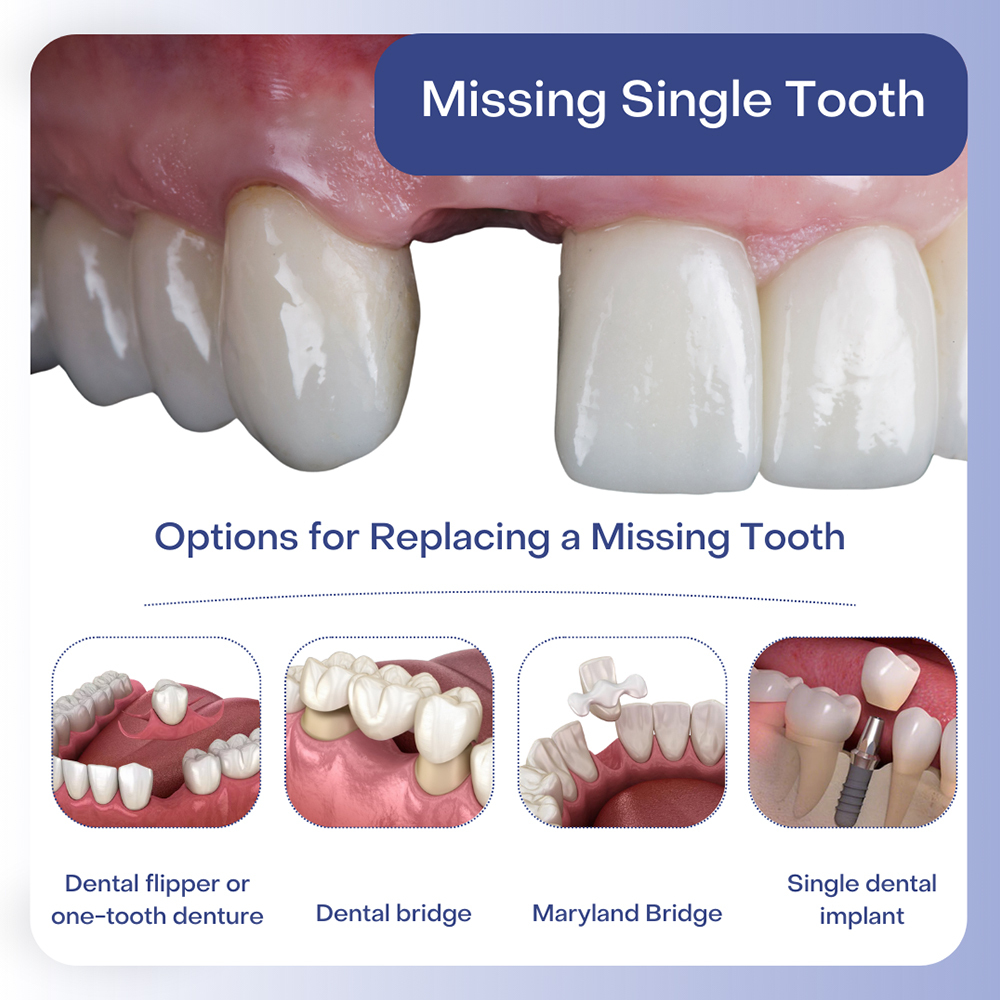Table of contents
Losing a single tooth is common, but missing even one tooth can affect your dental health. Although it might be tempting to leave a gap, especially if you cannot see it, restoring missing teeth is important as they are designed to work together as a unit.
 Below are some of the reasons why it’s important to restore a missing single tooth.
Below are some of the reasons why it’s important to restore a missing single tooth.
When you leave a gap, the teeth nearby start to shift toward it, destabilizing them and affecting your bite. The opposing tooth will also begin to overerupt, moving toward the space. When teeth move out of place, it can be hard to correct them.
There are several options available, including:
A one-tooth denture implant has a gum-colored acrylic base supporting a single tooth. It is a relatively small removable appliance but is only really to restore your appearance.
Dental flippers are not very comfortable or strong and lack stability. Usually, a dental flipper is provided as a temporary solution while you decide on a more permanent tooth replacement.
A dental bridge is a fixed prosthesis. It consists of crowns that are fitted over the adjacent teeth. These teeth are called abutment teeth; you usually need one strong and healthy abutment tooth on each side of the gap.
The abutment teeth must be ground down and reshaped to create enough room for the crowns. A replacement tooth called a pontic is attached between the crowns. The pontic is shaped to look like a real tooth and rests directly on the gum.
Usually, when you lose a single tooth, you will need a three-unit or three-tooth dental bridge. Sometimes, it may be possible to have a cantilever bridge, where only one abutment tooth is used to support the pontic, but this is less stable. Generally, cantilever bridges are only suitable when restoring front teeth.
Unlike a traditional bridge, a Maryland bridge uses wings for support. These can be made from metal or ceramic and are custom-made to fit on the inner surfaces of the abutment teeth. The pontic or replacement tooth is supported between the wings.
As the wings are quite small, there is no need to grind down the abutment teeth. Instead, the inner surfaces of the abutment teeth are lightly etched to increase the bond between the metal or ceramic wing and the tooth. However, a Maryland bridge isn’t very strong. The bond between the wings and the teeth can fail, so the bridge needs re-cementing.
We would only recommend a Maryland bridge when replacing a small front tooth, such as a lower front incisor that doesn’t come under very much pressure during biting. A Maryland bridge wouldn’t be suitable for restoring back teeth.
A single dental implant is largely regarded as the gold standard of missing tooth replacement options because it artificially replaces the entire tooth, including the tooth root.
An implant consists of a small screw or post that is inserted into your jawbone during a short surgical procedure, typically taking an hour or less to place. Once inserted, it soon fuses with the surrounding bone. The result is a strong anchorage point that can easily support an implant crown.
There are several reasons for choosing an implant to replace a missing single tooth.
A dental flipper is the cheapest solution, while a dental implant is the most expensive. However, an implant is frequently the best long-term option.
Ultimately, your choice of tooth replacement is likely down to personal preference, budget, and whether you wish to have oral surgery. When you visit our New Jersey dental clinic, we can talk you through all these options in more detail and show you examples of each, helping you make the right choice.

My name is Victoria Kushensky. I am a general dentist dedicated to remaining at the forefront of my field. Combining compassionate care with extensive knowledge, I offer cosmetic and general dentistry services as well as advanced root canal treatments.
I earned my Doctor of Dental Surgery (DDS) degree from the esteemed New York University College of Dentistry. Throughout my career, I have honed my skills in various dental procedures, ensuring effective treatment for each patient’s unique needs. I prioritize patient comfort and understanding, taking the time to thoroughly explain procedures and address any questions.
More about Dr. KushenskyMy NJ Dentist: Victoria Kushensky, DDS
385 Prospect Ave Suite 304
Hackensack, NJ 07601
(201) 298-8000